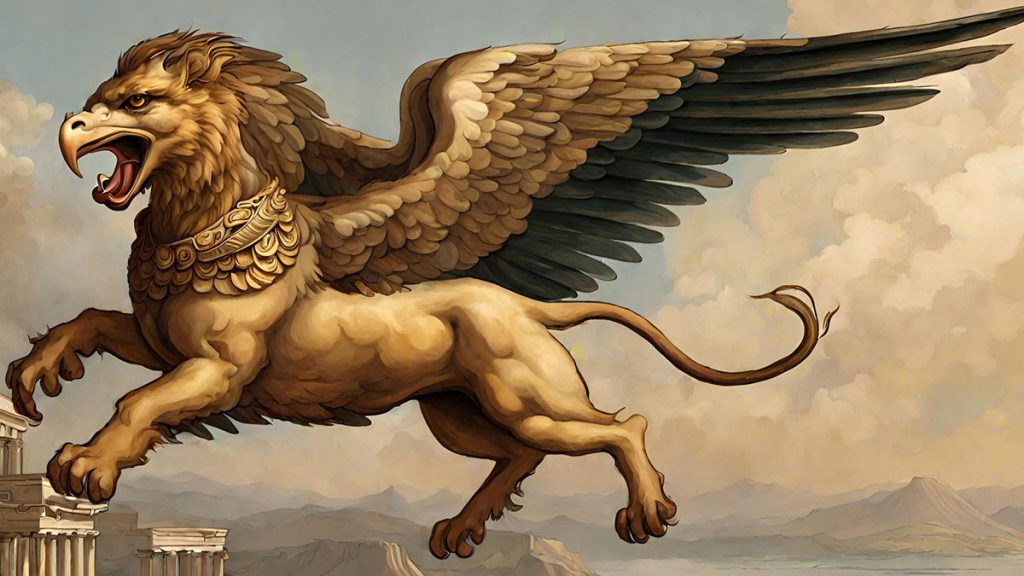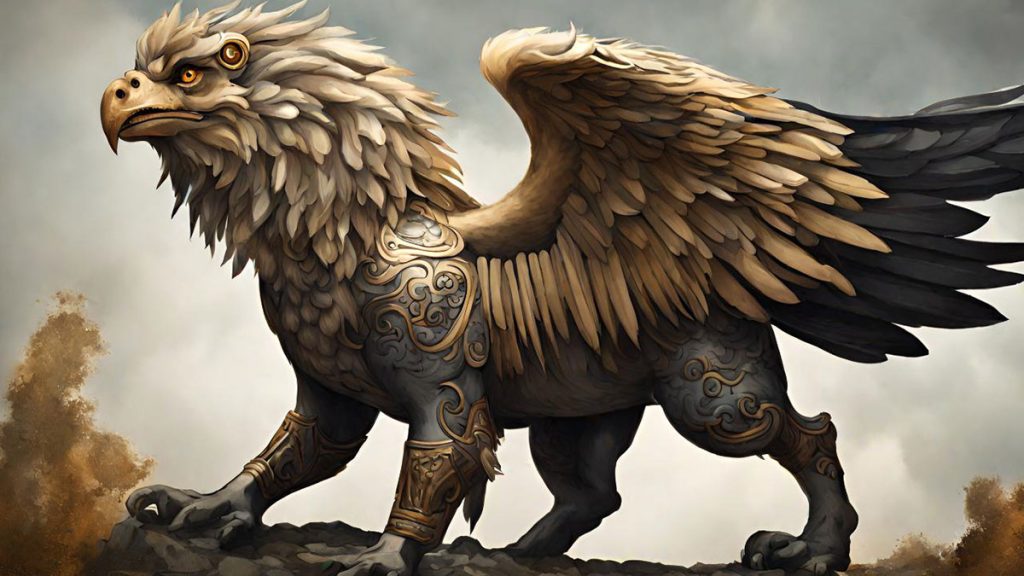The Griffin is an ancient mythical creature whose origins date back millennia to at least 5,000 years. Their origin is unknown, but their image has been found on artifacts from before the written word and from diverse areas such as ancient Egypt, Assyria, Babylonia, Persia, and ancient Greece.
It generally has the body of a lion but the head and torso of an eagle. It has four legs, a long beak, pointy ears, and talons on its front feet. It sometimes has a serpent’s tail. The animal is often winged, but only sometimes, and, seemingly, it mostly uses its legs to get around.
Griffins are thought to travel in packs, but they mate with only one partner. They eat large mammals, primarily horses and cows; however, they occasionally attack and consume humans. Later accounts claim Griffins lay eggs in burrows underground and that these nests contain nuggets of gold.
The creatures are generally thought of as symbols of power, wealth, and status. It’s easy to see why that is the case; the lion is the king of the land, and the eagle is the king of the sky, so combining them makes a formidable beast. Their image has appeared on coats of arms, banners, armorial shields, and on all kinds of heraldry for thousands of years. In modern times, many business firms use a Griffin on their logo, hoping to express an air of prestige.
Griffins represented in ancient cultures across Europe, Asia, and Africa
Griffins, or Griffin-like creatures, have been documented across Europe, Asia, and the Middle East. Their legend has become associated with gold, with some sources claiming they can be found residing in or near gold mines. Much like dragons, Griffins are thought to protect or hoard gold deposits. This could be because gold also became a symbol of great status, wealth, and power.
Artistic representations of Griffin-like creatures have been found on frescos and pottery dating back to the 4th millennium BC and have been found in ancient Persia and Egypt. However, the first descriptions and stories written down about the mysterious creatures came from Greek authors who were retelling tales from the Scythian people to the East. The beings started appearing in Greek pottery around the 7th century BC.

The Scythians were nomadic people who inhabited a vast area of land from the Black Sea to as far east as China and Mongolia. It is thought that Scythian gold miners from the Far East told tales of battling Griffins for their precious metals and that these tales traveled with merchants along the Silk Road. The legend of mysterious half-lion-half-eagle creatures that live in the Far East and guard vast treasures eventually reached Greek writers, and the legend spread from there.
Ancient Greeks were the first to document the Griffen
The Greeks gave the Griffins their name; Gryps is the Greek word for curved and hooked (perhaps referring to the animal’s talons), and Gryps was eventually Latinized and then Anglicized into Griffin.
Greek historian Herodotus, often considered the world’s first historian, wrote about the Griffins in the 5th Century BC. In Book 3 of his Histories, Herodotus wrote, “But in the north of Europe, there is by far the most gold. In this matter again I cannot say with assurance how the gold is produced, but it is said that one-eyed men called Arimaspoi steal it from Grypes [Griffins].”
And in Book 4, Herodotus wrote,
“Aristeas, possessed by Phoibos (Phoebus) [Apollon], visited the Issedones; beyond these (he said) live the one-eyed Arimaspoi (Arimaspians), beyond whom are the Grypes [Griffins] that guard gold, and beyond these again the Hyperboreoi, whose territory reaches to the sea. Except for the Hyperboreoi, all these nations (and first the Arimaspoi) are always at war with their neighbors; the Issedones were pushed from their lands by the Arimaspoi, and the Skythians [Scythians] by the Issedones.”
An earlier mention came from Aeschylus writing in Prometheus Bound circa 479 BC, “Beware of the sharp-beaked hounds of Zeus that do not bark, the Grypes [Griffins], and the one-eyed (monôpoi) Arimaspoi, mounted on horses, who dwell about the flood of Plouton’s stream that flows with gold. Do not approach them.”
Ctesias, also writing in the 5th Century BC, provided the first full description. From then on, the Griffin regularly appeared in art and literature across Greece and the Roman Empire. The Griffin then became linked with Greek Gods such as Zeus, Apollo, and Nemesis, thereby solidifying their association with power and status.

The Griffins later entered Western and Christian art, particularly from the 11th Century onward, when the crusading knights embraced them on their military banners and coats of arms. Outside of heraldry, the Middle Ages saw an abundance of paintings and drawings of Griffins, and they became a fashionable item for any discerning art critic.
In the 14th Century, a collection of short tales about a world traveler called The Travels of Sir John Mandeville emerged and discussed how the Griffin lived in a country called Bacharia in the East. Mandeville is generally assumed to be a fictitious character but the tales were reportedly based on some fact, albeit with many embellishments. From the 17th Century, stories about the Griffin had moved entirely from supposed factual accounts to the realm of pure fantasy. The legend has endured into modern times, appearing in movies and books such as Alice in Wonderland.
Did the Griffin legend come from dinosaur fossils?
A theory emerged in the 1990s that the Griffin legend may have followed the discovery of dinosaur fossils, particularly those of Protoceratops. Folklorist Adrienne Mayor argued that the Late Cretaceous period dinosaur, which lived around 75 to 71 million years ago, had many similarities to the Griffin. The Protoceratops had long beaks, four legs, and elongated shoulder blades that resembled wings, as well as a small bony frill that could resemble Griffin’s ears. The dinosaur was first documented in 1921.
The Protoceratops, just like the Griffin, lived in Asia, and a lot of its fossils were discovered in Mongolia’s Gobi Desert. The theory posits that the Scythians encountered these fossils while prospecting for gold, and when they told the ancient Greeks about what they had discovered, the legend of the Griffin gradually evolved.
Critics of this theory, such as paleontologist Mark Witton, argue that adherents focus solely on the Greek writers and ignore the many images of Griffins that featured in Near Eastern cultures thousands of years before the likes of Herodotus and Aeschylus. These images combined different species of animals; for example, sometimes, the head of a falcon or peafowl was used with the body of another cat-like animal.
It is likely we will never know who first thought to combine and eagle with a lion to create a Griffin.
References
American Museum of Natural History, “Griffin Bones,” accessed April 10, 2024.
Ancient Origins, “The ancient origins of the legendary griffin,” accessed April 10, 2024.
Chrysopoulos, Philip. “Griffins: The Noble Protectors of Ancient Greece,” in Greek Reporter, accessed April 10, 2024.
Mayor, Adrienne and Heaney, Michael. “Griffins and Arimaspeans,” in Jstor, accessed April 10, 2024.
PBS, “Why Has the Majestic Griffin Been Forgotten?” on Monstrum, accessed April 10, 2024.
Study.com, “Griffin in Greek Mythology,” accessed April 10, 2024.
Witton, Mark P. “Why Protoceratops almost certainly wasn’t the inspiration for the griffin legend,” in MarkWitton-com, accessed April 9, 2024.
